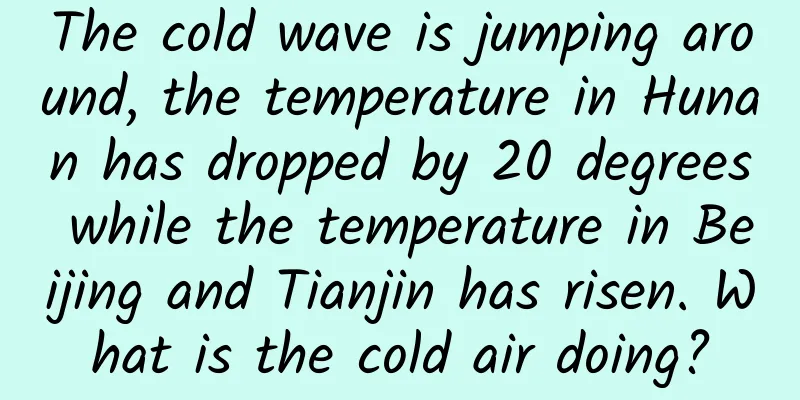The cold wave is jumping around, the temperature in Hunan has dropped by 20 degrees while the temperature in Beijing and Tianjin has risen. What is the cold air doing?

|
Cooling is relative. The amount of cooling caused by the same cold air depends not only on the intensity of the cold air, but also on the previous weather and the time of transit. The cold wave moved southward in a leaping manner. The daytime temperature in the north was not much lower because of the rain and snow in the past two days. In the south, Hunan was sunny yesterday, but today it was cloudy and rainy, and the temperature dropped by more than 20 degrees. There are many factors that affect temperature, and the direct cooling effect of cold air is often much smaller than the indirect effect. 1. Cold wave and temperature drop - Seemingly simple but actually not simple Today, the cold wave moved eastward and southward, driving away the snowfall in North China. How will the temperature change when the cold wave comes? Of course, the temperature will drop, but this cooling process is actually not simple. Let's take a look at the 24-hour temperature change chart of the country at 14:00 today (15th) compared with 14:00 yesterday: I marked three interesting points in the picture: 1. The cold wave started to pass through North China last night. This afternoon, the temperature in the western Shanxi and Inner Mongolia Plateau dropped by more than 10 degrees, but in the east, whether it is Beijing and Tianjin in the plains or Chengde in the mountains, the temperature drop is not obvious, and some even rose slightly. Is this because the cold wave is moving slowly and has not yet affected the east? 2. The temperature in Henan and Hubei in central China has risen compared to yesterday afternoon. Does this mean that the cold wave and cold air have not yet had an impact? 3. If the cold wave has not passed through central China, what will happen if the temperature in Hunan and southern Jiangxi in the Jiangnan region drops by more than 20 degrees? Let’s talk about these phenomena and their causes below. 2. Where has the cold wave gone? Is this a simple question? Just looking at the temperature is a bit confusing, so let's look at the wind: Observed wind gusts > 6 at 14:00 on December 15, 2023 Too dark to see? Zoom in. Cold wave and strong winds have arrived in eastern North China: The sudden northerly wind in the Sichuan Basin and Jianghan Plain is also a cold front: Even in the Dongting Lake Plain and Poyang Lake Plain south of the Yangtze River, the north wind is blowing strongly: If we zoom in on the Jiangnan region in the first temperature drop chart above, the temperature drop figures will be as shown below: 24-hour temperature change observed at 14:00 on December 15, 2023 So considering the north wind and the temperature drop, the fastest moving part of the cold air has moved from central China to southern Hunan and into Guilin in northern Guangxi. This is much faster than the normal speed of cold air moving south. There must be something wrong when something is abnormal. 3. The cold wave seems to be jumping around? We selected five national observation stations from north to south (Beijing Observatory, Yunzhou, Datong, Shanxi, Xiangyang, Hubei, Guiyang, Hunan, Xing'an, Guangxi) to look at the changes in meteorological elements over the 24 hours from 14:00 on the 14th to 14:00 on the 15th, and we can know the time when the cold air will arrive and affect: Sea level pressure field at 14:00 on December 15, 2023 In Yunzhou, Datong, the cold wave began to affect the area around 02:00 on the 15th, and the 24-hour temperature dropped by 11 degrees compared to before the impact. In Beijing, the cold wave began to affect Beijing at around 04:00 on the 15th, and the 24-hour temperature dropped by about 1 degree compared to before the impact. In Xiangyang, Hubei, the cold wave began to affect the area around 06:00 on the 15th, and the 24-hour temperature change was about 3 degrees higher than before the impact. In Guiyang, Hunan, the cold air began to affect the area around 05:00 on the 15th, and the 24-hour temperature dropped by 21 degrees compared to before the impact. In Xing'an, Guangxi, the cold air began to affect the area around 08:00 on the 15th, and the 24-hour temperature dropped by 14 degrees compared to before the impact. Here comes the interesting thing. Combining all the previous information, it can be confirmed that the above five stations were all affected by the cold wave at the latest this morning, and all the stations had not been affected by the cold wave at 14:00 on the 14th. At 14:00 on the 15th, all were already in the cold wave, but the 24-hour temperature change was a sharp drop and even a rise. What's even more bizarre is that the cold air affected Guiyang, Hunan in the south, one hour earlier than Xiangyang, Hubei, more than 600 kilometers to the north. Could it be that the cold air from north to south really jumped? 4. The Jianghuai cyclone helps the cold wave "jump" into the south The observation data above shows that "Guiyang was affected by cold air before Xiangyang" is true. The reason behind it is a perfect example of the complexity of weather. The reason is: In essence, the cold air that affects Guiyang is not the cold air that affects Xiangyang; the cold air that affects Guiyang is the cold air produced by the Jianghuai cyclone, while the cold air that affects Xiangyang is the real cold wave cold air; after moving southward, the cold wave cold air merges into the cold air produced by the Jianghuai cyclone and becomes one. Will a cyclone generate its own cold air? Yes, this knowledge is too professional so I won't go into it. To put it simply: I have said before that the convergence of cold and warm air may produce a cyclone, but cyclones are not always caused by the convergence of cold and warm air. This time, the Jianghuai cyclone was formed by the precipitation feedback effect under the dominance of warm air. Precipitation will generate cold air on the ground (by shielding the sun's radiation and absorbing latent heat through raindrop evaporation). In short, the western part of the Jianghuai cyclone will have self-generated cold air that caused a significant drop in temperature in the south of the Yangtze River before the cold wave. Its "paving the way first" effect caused the cold wave to move south rapidly on a macro level. The following figure shows the weather situation at 02:00 on the 15th, 12 hours ago. Draw the fronts of the two cold fronts and match the time when the above-mentioned places were affected by the cold fronts. Everything is clear: Weather conditions at 02:00 on the 15th (sea level pressure) At 02:00 on the 15th, the main cold wave front had just arrived in Datong, 2 hours away from Beijing and 4 hours away from Xiangyang. The front of the cold air produced by the cyclone was 3 hours away from Guiyang and 6 hours away from Xing'an. During the day on the 15th, the main force of the cold wave caught up with the cold air produced by the cyclone. The merger of the two cold air masses created the seemingly impossible but actually very natural "counter-common sense" meteorological knowledge: "the cold wave quickly jumped southward" and "northern Xiangyang was affected by the cold air later than southern Guiyang". 5. Commonplace: It’s not just cold air that affects the temperature Recently, I have been tirelessly talking about the multiple factors that affect the temperature (see "The north wind is blowing, and the temperature is rising - a brief analysis of the root cause of the misunderstanding of "pre-frontal warming"), in order to explain the complex temperature changes. Back to the three questions at the beginning, the core reason is actually one: the effect of solar radiation on temperature caused by the difference in daytime weather before and after the cold wave is greater than the cold advection effect of the cold air of the cold wave. A simple explanation is as follows: 1. The cold wave swept through North China, causing a sharp drop in temperature in the western part while the eastern part did not show any significant drop in temperature or even warmed up? Answer: Because the snow stopped and the clouds became thinner in the west at 2 p.m. on the 14th, the solar radiation heating made the base temperature high, and the temperature dropped significantly when the cold wave arrived during the day on the 15th; it was already very cold in the east as it was still snowing during the day on the 14th, and the snow stopped and the clouds became thinner during the day on the 15th, and the solar heating effect reduced the cooling of the cold wave. The overall effect was that the temperature did not drop significantly, and it even rose slightly. 2. The temperature in Henan and Hubei in central China actually rose in the afternoon of the 15th compared to the afternoon of the 14th. Does this mean that the cold wave and cold air have not yet had an impact? Answer: Same reason as above. During the day on the 14th, places like Henan and Hubei were still covered by thick rain and snow clouds. It was very cold without the sun. During the day on the 15th, the clouds became thinner and the sun even shone in some places. Coupled with the possible warming effect of the sinking cold air, the cooling effect of the cold wave was not obvious. 3. If the cold wave has not passed through central China, what will happen if the temperature in Hunan and southern Jiangxi in the Jiangnan region drops by more than 20 degrees? Answer: As mentioned earlier, the sharp drop in temperature in the south of the Yangtze River during the day on the 15th was the result of the cold air produced by the Jianghuai cyclone. It is worth mentioning that the intensity of this self-produced cold air itself is not very large, but it has a significant effect on indirectly affecting the cooling by causing rainfall and blocking the sun, ultimately achieving the effect of a 20-degree drop in temperature compared to 14:00 on the 14th (when it was a sunny and warm day). In conclusion: This is the limitation of using point-to-point temperature changes to measure the intensity of cold air. Due to the influence of the aforementioned multiple factors, this 24-hour temperature comparison often cannot reflect the true intensity of the cold air itself, especially when it comes to daytime temperature changes. It is relatively more accurate to measure the intensity of cold air by the change in daily average temperature or daily minimum temperature before and after the cold air process. This is also the standard used by the China Meteorological Administration to draw the cooling of cold air, and it is the most reasonable and scientific standard. But ironically, this most scientific measurement standard is often inconsistent with the public's perception of cooling, various common sense, and even the "cooling" on the surface of the data. The most classic case is the Baiyin incident in Gansu. Those who are interested can refer to my article two years ago, "In order to commemorate the unforgotten - "Numbers" on the "high-impact" weather of the Gansu Baiyin Mountain Marathon tragedy." ---End of full text--- Welcome to follow the official account: Taotao Fengyun |
<<: What does a doctor mean by "light diet"? I bet few people know
Recommend
Is it expensive to produce the Zhuhai ticketing mini program? Zhuhai Ticketing Mini Program Production Cost and Process
How much does it cost to produce the Zhuhai ticke...
Does high temperature only make people emo? From a geological perspective, its contribution is not small!
Recently, the temperature in most parts of my cou...
Screen supplier failure leads to delay in iPad Pro production
[[128713]] According to Bloomberg, sources said t...
Is the investment fee for Tangshan cosmetics mini program high? Tangshan Makeup Mini Program Investment Fees and Process
How much is the investment cost for Tangshan Make...
6 conversion rate analysis models to improve product conversion!
1. Why is conversion rate becoming more and more ...
List of 7 essential promotion skills for operators!
Promotional methods + operational knowledge = imp...
Academicians teach you how to choose a major | Do you want to be a "chief engineer"?
Your browser does not support the video tag Edito...
Momo and Tantan: The secret behind a 60% monthly user retention rate
When it comes to domestic stranger social softwar...
Quantitative Learning Cloud Lecture Hall Wang Yan's Four-dimensional Three-first Selection and Following the Banker Basic Training Class 28th
The 28th session of Wang Yan's Four-dimension...
Xinjiang 40℃ VS Jiangsu, Zhejiang and Shanghai 40℃, what’s the difference?
#Zhejiang is already too hot to work#! In recent ...
Analysis of AARRR (user growth) model: How to achieve user growth?
This article starts from the experience and expla...
Analogous to WeChat, how to compress Apk to the extreme, talk about the 8 steps of Android compression
Introduction As the project continues to iterate,...
7 cases of strategic product operations!
In practice, product operators often face many pr...
What is the minimum monthly consumption for 400 calls?
According to the data collected by customer servi...
Tips on how to choose a 400 number when applying for one
Now there are many companies that need to apply f...









